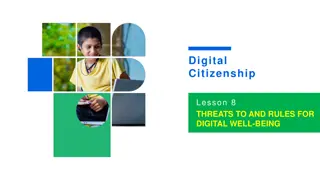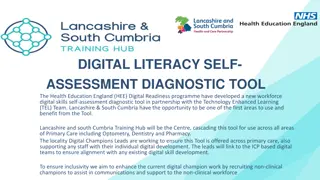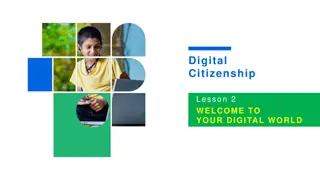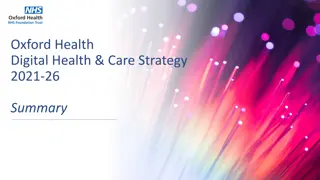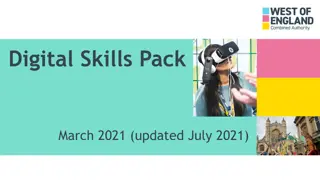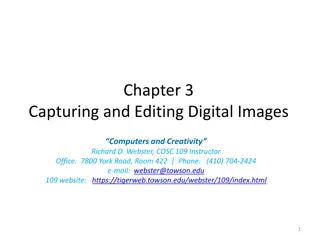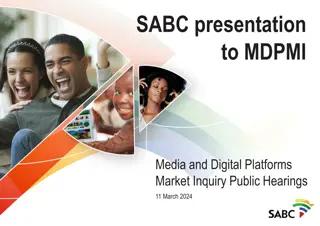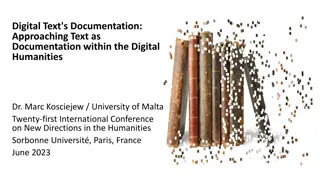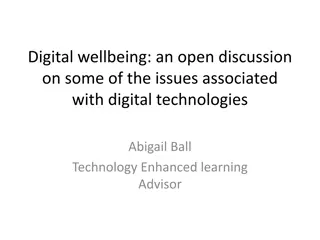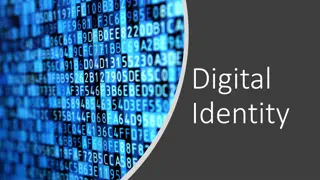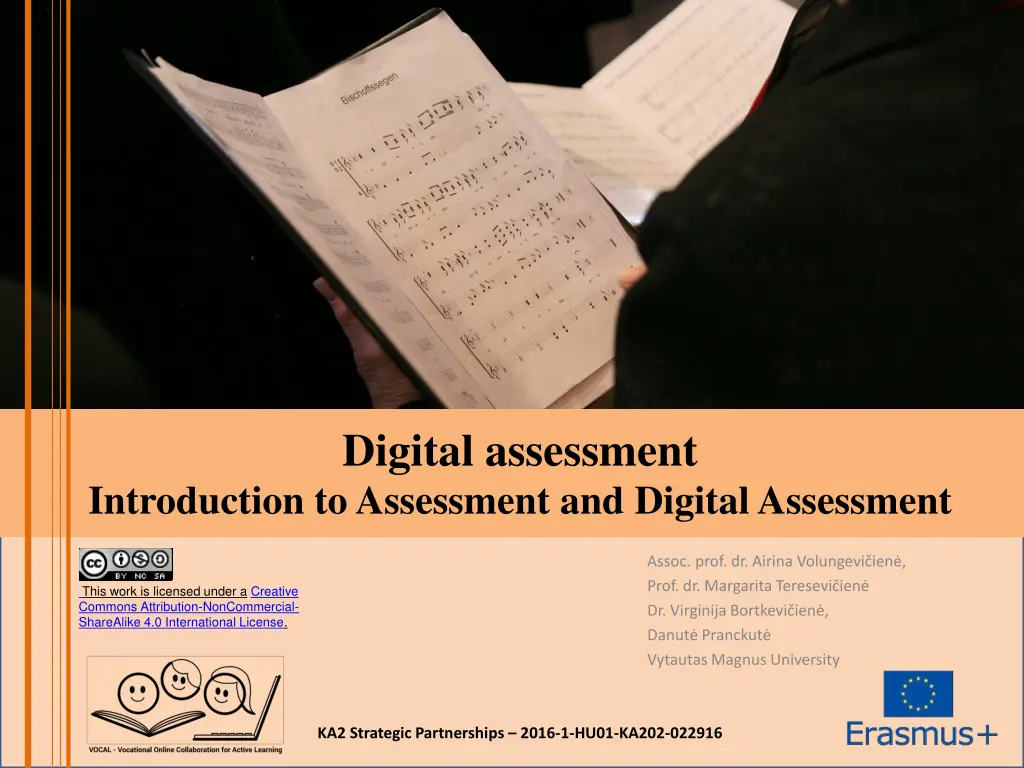
Understanding Digital Assessment in Learning Processes
Explore the role of assessment in the learning process, different forms of assessment, purposes of assessment, types of assessment, the feedback cycle in online assessment, and the importance of assessment in encouraging learning, providing feedback, and developing skills. Dive into the world of digital assessment with insightful resources and references.
Download Presentation

Please find below an Image/Link to download the presentation.
The content on the website is provided AS IS for your information and personal use only. It may not be sold, licensed, or shared on other websites without obtaining consent from the author. If you encounter any issues during the download, it is possible that the publisher has removed the file from their server.
You are allowed to download the files provided on this website for personal or commercial use, subject to the condition that they are used lawfully. All files are the property of their respective owners.
The content on the website is provided AS IS for your information and personal use only. It may not be sold, licensed, or shared on other websites without obtaining consent from the author.
E N D
Presentation Transcript
Digital assessment Introduction to Assessment and Digital Assessment reative Commons License Assoc. prof. dr. Airina Volungevi ien , Prof. dr. Margarita Teresevi ien Dr. Virginija Bortkevi ien , Danut Pranckut Vytautas Magnus University This work is licensed under a Creative Commons Attribution-NonCommercial- ShareAlike 4.0 International License. KA2 Strategic Partnerships 2016-1-HU01-KA202-022916
INTRODUCTION TO ASSESSMENT AND DIGITAL ASSESSMENT In the learning process assessment plays a very important role and is at the center of the learning process. Assessment is defined as any processes that appraise an individual s knowledge, understanding, abilities or skills. There are many different forms of assessment, serving a variety of purposes (QAA Quality Code (2012), Chapter B6). References: QAA Code of Practice for Academic Quality and Standards of Higher Education 2000 KA2 Strategic Partnerships 2016-1-HU01-KA202-022916
INTRODUCTION TO ASSESSMENT AND DIGITAL ASSESSMENT Purposes of assessment: To encourage students learning by providing feedback; To assess student knowledge, understanding and skills; To give a mark or degree to determine student's performance; To enable the public (including employers) and higher education institutions to understand that a person has achieved an appropriate level of achievement References: QAA Code of Practice for Academic Quality and Standards of Higher Education 2000 KA2 Strategic Partnerships 2016-1-HU01-KA202-022916
INTRODUCTION TO ASSESSMENT AND DIGITAL ASSESSMENT Types of assessment: watch the video https://youtu.be/Xd_QgdtFn54 KA2 Strategic Partnerships 2016-1-HU01-KA202-022916
ASSESSMENT FEEDBACK CYCLE Online assessment has digital approaches as core components of formal submission, marking, feedback or assignment-handling processes References: https://elearningyork.wordpress.com/learning-design-and-development/technology-enhanced- learning-handbook/york-tel-handbook-6-assessment-and-feedback/6-1-digital-assessment KA2 Strategic Partnerships 2016-1-HU01-KA202-022916
Why? What? How? Why Assess? It encourages learning: It provides feedback: It develops skills and abilities; It allows to be graded or ranked It validates certification procedures for professional practice. References: https://www.adelaide.edu.au/learning/teaching/assessment/introduction KA2 Strategic Partnerships 2016-1-HU01-KA202-022916
Why? What? How? What Assess? Cognitive Skills and Capabilities; Affective Skills and Capabilities; Psychomotor Skills and Capabilities; Communication Skills and Capabilities. References: https://www.adelaide.edu.au/learning/teaching/assessment/introduction KA2 Strategic Partnerships 2016-1-HU01-KA202-022916
Why? What? How? How Assess? Assessment could contain the following sections: Assessing Group Work Quality and Standards Academic Honesty Online Assessment Assessing Large Classes Assisting International Students. References: https://www.adelaide.edu.au/learning/teaching/assessment/introduction KA2 Strategic Partnerships 2016-1-HU01-KA202-022916
BENEFITS OF DIGITAL ASSESSMENT Provide immediate feedback; Potentially increase learners' autonomy, agency and self-regulation; Support for collaborative learning; Provide authenticity; Widen range of measurement; Flexible and appropriate responses; Increase efficiency and reduce teachers' workloads; Based on: JISC 2010; Pellegrino & Quellmalz 2010; Winkley 2010; Schwartz and Arena 2009; Angus and Watson, 2009; Whitelock and Watt, 2008; Whitelock et al., 2006 KA2 Strategic Partnerships 2016-1-HU01-KA202-022916
BENEFITS OF DIGITAL ASSESSMENT Improve student performance; Integrate formative and summative assessments; Improve assessment validity and reliability. Based on: JISC 2010; Pellegrino & Quellmalz 2010; Winkley 2010; Schwartz and Arena 2009; Angus and Watson, 2009; Whitelock and Watt, 2008; Whitelock et al., 2006 KA2 Strategic Partnerships 2016-1-HU01-KA202-022916
CHALLENGES/BARRIERS TO DIGITAL ASSESSMENT Practitioners' concerns about the problem of plagiarism detection and invigilation; Difficulties in scalability and transferability of practices, especially HE, where different departments often have independent, separate work practices and cultures; Concern about the reliability and validity of a high risk assessment (eg, How to ensure that all students receive equivalent tests if questions are randomly selected from a question bar); User authentication and security issues; Based on: Mogey, 2011; Mansell, 2009; Whitelock and Watt, 2008; Ripley, 2007; Whitelock et al, 2006; Whitelock and Brasher, 2006 KA2 Strategic Partnerships 2016-1-HU01-KA202-022916 11
CHALLENGES/BARRIERS TO DIGITAL ASSESSMENT Lack of staffing time and training in order to review the evaluation strategies and how to use technology from a technological and pedagogical perspective; Investment costs. New technologies and their systems requires significant investment in training, support and interoperability. In addition, certain tools require high capital investment and infrastructure that many institutions do not want to prioritize (for example, having enough computers to conduct screening tests); The expert councils and exam boards are very concerned that standards will not be affected; Based on: Mogey, 2011; Mansell, 2009; Whitelock and Watt, 2008; Ripley, 2007; Whitelock et al, 2006; Whitelock and Brasher, 2006 12 KA2 Strategic Partnerships 2016-1-HU01-KA202-022916
CHALLENGES/BARRIERS TO DIGITAL ASSESSMENT Lack of political leadership and the whole system; Limitations to the exam system, especially in secondary and FE sectors; Lack of suitable physical spaces for advanced technologies that are not designed to meet the needs and objectives of technology enhanced assessment. Based on: Mogey, 2011; Mansell, 2009; Whitelock and Watt, 2008; Ripley, 2007; Whitelock et al, 2006; Whitelock and Brasher, 2006 13 KA2 Strategic Partnerships 2016-1-HU01-KA202-022916
References QAAQuality Code (2012), Chapter B6; Angus, S.D. and Watson, J. (2009) 'Does regular online testing enhance student learning in the numerical sciences? Robust evidence from a large data set'. British Journal of Educational Technology, 40 (2), pp.255-272 JISC (2010) Effective Assessment in a Digital Age. A JISC report. Available from http://www.jisc.ac.uk/media/documents/programmes/elearning/digiassass_eada.pdf Mogey, N. (2011) 'What is it that is really acting as a barrier to widespread use of summative e- assessment in UK higher education?' International Journal of e-Assessment, 1(1). Pellegrino, J. W. & Quellmalz, E.S. (2010) 'Perspectives on the Integration of Technology and Assessment'. Journal of Research on Technology in Education, 43 (2), pp. 119-134 Ripley, M. (2007). E-assessment an update on research, policy and practice: Report 10 update. Futurelab. Available online at http://archive.futurelab.org.uk/resources/publications- reports-articles/literature-reviews/Literature-Review204 39 Technology Enhanced Assessment: Review of the Literature KA2 Strategic Partnerships 2016-1-HU01-KA202-022916
References Whitelock, D. (2010) 'Activating Assessment for Learning: are we on the way with Web 2.0?' In Lee, M.J.W. and McLoughlin, C. (Eds.) Web 2.0-Based-E-Learning: Applying Social Informatics for Tertiary Teaching. IGI Global. pp. 319 342. 40 Technology Enhanced Assessment: Review of the literature-assessment Whitelock, D. and Watt, S. (2008) 'Reframing e-assessment: adopting new media and adapting old frameworks'. Learning, Media and Technology, 33 (3), pp. 151-154 Whitelock, D. and Brasher, A. (2006) Roadmap for e-assessment. A JISC report. Available from: http://www.jiscinfonet.ac.uk/InfoKits/effective-use-of-VLEs/resources/roadmap-for- assessment Winkley, J. (2010) E-assessment and innovation. A Becta report. Available from: emergingtechnologies.becta.org.uk Schwartz, D.L. & Arena, D. (2009) Choice-Based Assessments for the Digital Age. Stanford University. Available from: http://dmlcentral.net/sites/dmlcentral/files/resource_files/ChoiceSchwartzArenaAUGUST2320 09.pdf KA2 Strategic Partnerships 2016-1-HU01-KA202-022916
References https://www.adelaide.edu.au/learning/teaching/assessment/introduction; https://elearningyork.wordpress.com/learning-design-and-development/technology- enhanced-learning-handbook/york-tel-handbook-6-assessment-and-feedback/6-1-digital- assessment/ KA2 Strategic Partnerships 2016-1-HU01-KA202-022916







